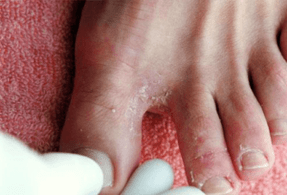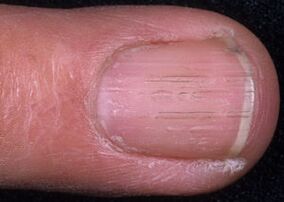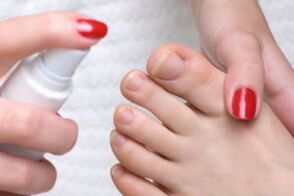Foot fungus is a skin disease, manifested by active reproduction in the epidermis of certain fungi. Nowadays, both the elderly with weakened immune systems and children are susceptible to this disease. Signs of fungus on the feet depend on the type of pathogen of the infectious process and the volume of the affected feet and nails, and at different stages there are certain differences, which indicate progressiondevelopment of the infection. You should know how to recognize fungus on your feet so that you can start treating it promptly and prevent its further growth.

Symptoms of the disease
The main place for fungal growth on the feet often becomes the area between the toes. This pathology is accompanied by the appearance of symptoms such as burning, intense itching and redness of the epidermis. In addition, a person may observe flaking and peeling skin, as well as the formation of blisters on the legs and increased dryness of the dermis.
Similar symptoms of foot fungus can occur on the soles of shoes and are accompanied by excessive keratinization of the skin. The insidiousness of this disease lies in the fact that, in its course, it is possible to form a difficult-to-treat fungus on the feet, and the wounds themselves are in a state of superinfection.
How to recognize fungus on the feet, and what symptoms can signal the beginning of the development of the disease? The first signs of the disease are the appearance of small scales, that is, there are various forms of peeling, from small to large scales. There are different types of fungi that provoke the development of the disease, but they are all characterized by the same signs:

- At the initial stage of development, the pathology progresses without the appearance of obvious symptoms. First of all, the folds between the thumbs are affected and most often between the third and fourth fingers.
- As the fungal disease progresses, the sides of the feet are affected, spreading to the ankles.
- With a fungal infection of the feet, the skin thickens noticeably, cracks, and begins to shine.
- The skin becomes too dry and starts to itch a lot. In addition, the epidermis becomes very red and its affected areas become inflamed.
- The patient begins to complain of pain and burning in the feet.
- With the transition of the disease to a lethargic form, blisters begin to appear on the skin. When they are opened, the affected areas of skin will be very wet and tender.
There are several forms of foot fungus, and each is accompanied by the development of certain symptoms.
Types of diseases
Experts identify the following fungi that can affect the skin on the feet:
- interdigital;
- hyperkeratosis (moccasin);
- resolution disorder.
The most common form of toenail fungus on the feet is interstitial fungus, which is characterized by the appearance of certain signs:
- most often, the area \u200b \u200 of the fourth and fifth toes becomes inhabited by this form of fungus.
- as the disease progresses, the skin is characteristically scaly and may severely crack;
- between 3, 4, and 5 form a fissure or weeping funnel, surrounded by dry white or greenish scales.

Fungal skin lesions between foci can be dry or wet. In the event that a damp vaginal fungus is found, the skin will be swollen. With a dry lesion of the epidermis, its peeling and shedding are noted.
The first sign of moccasin-like foot fungus is pain, the manifestation of which is observed in the feet. As the pathology progresses, the skin on the sole of the shoe gradually thickens, causing the formation of cracks.
This is the most difficult to treat and most overlooked form of fungal foot disease, but it is easy to recognize. Fungal diseases can manifest themselves by peeling off the nail plates, in which case they have a characteristic thickness, are prone to crumbling and may even fall off altogether.
The vesicular form of the fungus is characterized by the formation of vesicles with a clear liquid inside. Gradually, these vesicles mature, become opaque and open, causing erosion of various sizes. The main area of the blisters becomes the area closer to the toes on the sole of the shoe, but they can develop a rash all over the skin of the shoe.
The vesicular form of mycosis is considered quite rare, but much easier to treat. This is due to the fact that the blister becomes the site of localization of the pathogen, that is, it does not penetrate into the deeper layers of the skin. When a viral or fungal infection accompanies vesicular mycosis, severe skin lesions are observed and treatment becomes difficult.
Specialists distinguish a cleared form of fungus on the legs, in which all symptoms are blurred. Diagnosing such a pathology is quite difficult, since the affected skin looks like a simple ungroomed leg. In a patient with such foot fungus, the symptoms were yellow nails, peeling skin of the feet but were so mild that the patient did not pay attention.
The eradication of the fungus occurs in waves, that is, in the hot season the disease becomes more severe, and in the winter it almost completely disappears. With any weakening of the immune system, an exacerbation of the disease is observed, which makes it difficult to treat foot fungus.
How to recognize nail fungus?
Signs of nail fungus can vary significantly at different stages, signaling the progression of the infection. How does toenail fungus start and what signs should I look out for?

- In the early stages, there are no characteristic symptoms of the lesion and hardly noticeable stripes and spots appear on the nails. In the event that you ignore the first signs of the disease and start to get a fungal infection, then the possibility of accumulation of pus in the area around the edge is quite possible. The result of such a pathological process is necrosis or amputation of the lower extremities.
- With the second degree of fungal disease, the natural shine on the nails will disappear. Gradually, the nail changes color and forms white and brown stripes on it. Deformation of the upper part of the nail and the lateral parts of the nail may occur. The advanced stage of bacterial nail damage is characterized by increasing fragility, delamination, and inflammation of the cuticle. The disease continues to progress and spread to other fingernails and toenails.
- In the third stage of onychomycosis, the nails turn dirty yellow or brown. In addition, it becomes too loose, thickens and lags behind the nail bed. Often, when wearing shoes, severe pain begins and itchy skin becomes simply unbearable.
There are several types of fungal infections of the toenails, each of which causes the appearance of certain symptoms.
- Hypertrophic onychomycosis is accompanied by thickening and yellowing of the nail. Broken nails and thickened cuticles are visible under the nail.
- Atrophic nail disease causes thinning of the nail and destruction of the nail, and the stratum corneum can be seen under the nail.
- Onychomycosis, when it comes to mold, often develops not as an independent disease, but against the background of other pathologies.
Nails can be dyed yellow, brown, green or black. Most often, a complication develops in the form of perioral inflammation accompanied by pus.
Disease prevention

With the normal functioning of the immune system, nail fungus is unlikely to start growing after an infection, as the body can't deal with it on its own. In cases where a fungal infection still affects the feet and nails, effective treatment is required. The sooner the fight against such a pathology begins, the better the patient's chances of a full recovery.
Fighting foot fungus is considered a rather laborious process, so it is easier to prevent the development of the disease. To do this, the following precautions must be observed:
- keep feet dry;
- do not wear other people's shoes;
- choose socks made of cotton fabric;
- Don't run barefoot on the beach.
When the first signs of fungus on the feet appear, you should contact a specialist. It is important to identify the disease early in its development and prevent its progression, which will help avoid many complications. To understand how to identify fungus on the feet, you need to consult a dermatologist.



























